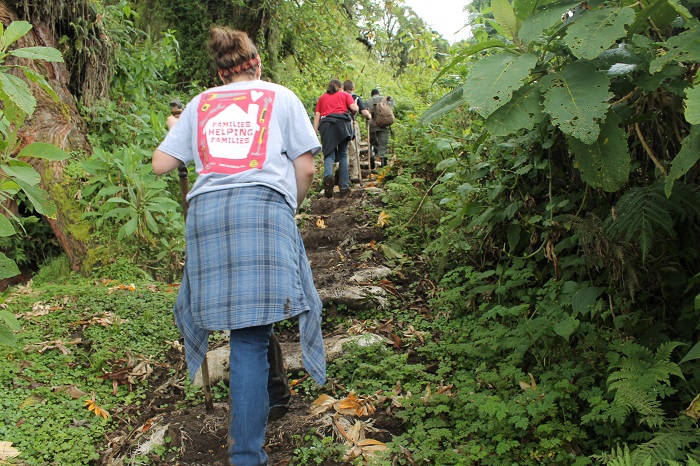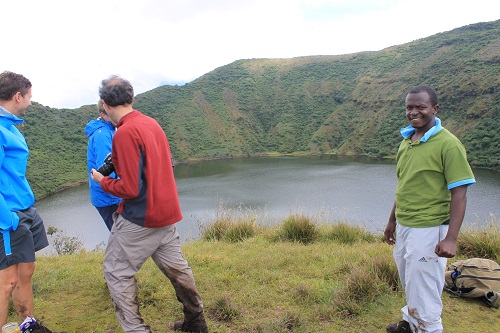
Mount Bisoke volcano is the most popular hiking destination in Rwanda, with 10s of hiking enthusiasts taking on the challenge every day. Mt Bisoke is found in Volcanoes National Park in the north of Rwanda and is one of the five volcanic cones that make up the park, the others being mountains; Karisimbi, Gahinga, Sabyinyo, and Muhavbura.
The number one aim of the hike on Mount Bisoke is to see the large beautiful crater lake at the peak, which is the largest of the crater lakes in the Virunga mountains with a diameter of 400 meters. While there are also many travelers who want to experience the volcanoes but cannot afford the expensive gorilla trekking and so decide to go for the mount Bisoke hike knowing there is a chance to see the gorillas on the hike.
The Bisoke crater lake hike is a one-day tour meaning hikers climb to the top of the volcano and return to base in one day. There is no camping or overnighting on the volcano.
The hike from the base to the peak of the Bisoke volcano takes on average 4 hours, depending on one’s pace and weather.
The seasoned hikers and mountain climbers can reach the summit in 2 hours or even less, while hiking newbies who endure can take up to 6 hours to get to the peak.
However, there are also many of who sign up for Mount Bisoke hike that give up within 30 minutes after starting the trek. This begs the question, how difficult or hard is this trek and who can do this hike?
How difficult is the Mount Bisoke hike?
The level of difficulty of the Mount Bisoke hike can be put at challenging to difficult.
The perfect conic shape makes a difficult hike
Mount Bisoke has a perfect conic shape with a steady rise from the base to the peak. This means you continuously are climbing up, and faced with the fast dropping oxygen levels as you go higher, the muscles will tire quite fast. And, as much as you will be encouraged to trek at your own pace, you are still under pressure to reach at the peak within a particular time limit to avoid the sudden change in weather at the peak. The peak of Mt Bisoke is constantly shrouded in a cloud of fog which can generate a thunderstorm at any time. This normally happens later in the afternoon and so the guides want everyone to get to the peak early enough to avoid the afternoon thunderstorms and poor visibility from the cloud cover.
The dense forest and vegetation cover
The Bisoke volcano is also fully covered with mountain vegetation of varying types in the different altitude zones. The lower zones have the forests and thick vegetation and these areas present the biggest challenge of the hike. It is no wander many hikers give up from the lower levels of the mountain. As you get to the higher altitudes the vegetation cover is less and the hike is easier.
Hiking in the wet season is an extreme adventure
Hiking during the rainy season presents the most difficult Mount Biske hike. The rainy seasons are from March to April and October to November. During the rainy or wet season the mountains receive almost daily rains. This makes the trail very muddy and slippery. If you have to trek during the rainy season, expect a hard trek and be prepared for it.
Your fitness will determine how difficult the hike will be
Many who think they will simply rely on their strong will without any fitness to make it to the crater lake are rudely awakened when their legs cannot climb any higher after 30 minutes of ascending up the mountain.
Altitude sickness
As you climb higher the oxygen levels drop. And, if come from a low elevation or altitude your body is used to using a lot of oxygen. When faced with the dropping oxygen elevations the body will tire very fast and you will be faced with a difficult hike, even with a degree of fitness. Acclimatizing to the high altitude with less oxygen will improve your ability to hike. You stay in Musanze/Ruhengeri in the foothills of the Virungas for a few days before taking on the hike.
Mount Bisoke hike is a physical challenge as much as a mental challenge
If the Bisoke hike is your first real mountain hike, your mental strength will be as important as your physical strength. After 2 hours of hiking and past half way the hike, your brain will start telling to give up but you must overcome these thoughts and declare that you must see the crater lake. That you are not a quitter or failure!
Can I do an easier hike in Volcanoes national park?
Lake Ngezi hike on Mount Bisoke
Dian Fossey tomb trek
